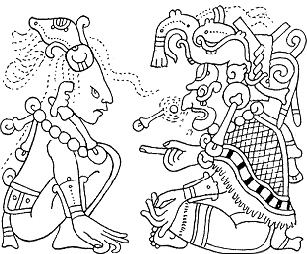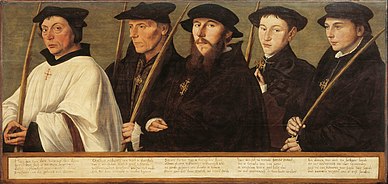
A pilgrimage is a journey, often into an unknown or foreign place, where a person goes in search of new or expanded meaning about their self, others, nature, or a higher good through the experience. It can lead to a personal transformation, after which the pilgrim returns to their daily life.

Jehovah's Witnesses is a nontrinitarian, millenarian, restorationist Christian denomination. As of 2022, the group reported approximately 8.5 million members involved in evangelism, with 19.7 million attending the annual Memorial of Christ's death. The denomination is directed by a group of elders known as the Governing Body of Jehovah's Witnesses, which establishes all doctrines. Jehovah's Witnesses believe that the destruction of the present world system at Armageddon is imminent, and the establishment of God's kingdom over earth is the only solution to all of humanity's problems. The group emerged in the United States from the Bible Student movement founded in the late 1870s by Charles Taze Russell, who also co-founded Zion's Watch Tower Tract Society in 1881 to organize and print the movement's publications. A leadership dispute after Russell's death resulted in several groups breaking away, with Joseph Franklin Rutherford retaining control of the Watch Tower Society and its properties. Rutherford made significant organizational and doctrinal changes, including adoption of the name Jehovah's witnesses in 1931 to distinguish the group from other Bible Student groups and symbolize a break with the legacy of Russell's traditions.
Jehovah's Witnesses's practices are based on the biblical interpretations of Charles Taze Russell (1852–1916), founder of the Bible Student movement, and of successive presidents of the Watch Tower Society, Joseph Franklin Rutherford and Nathan Homer Knorr. Since 1976, practices have also been based on decisions made at closed meetings of the group's Governing Body. The group disseminates instructions regarding activities and acceptable behavior through The Watchtower magazine and through other official publications, and at conventions and congregation meetings.
A religious order is a lineage of communities and organizations of people who live in some way set apart from society in accordance with their specific religious devotion, usually characterized by the principles of its founder's religious practice. It is usually composed of laypeople and, in some orders, clergy. Such orders exist in many of the world's religions.

A number of corporations are in use by Jehovah's Witnesses. They publish literature and perform other operational and administrative functions, representing the interests of the religious organization. "The Society" has been used as a collective term for these corporations.
The Watchtower Announcing Jehovah's Kingdom is an illustrated religious magazine, published by the Watch Tower Bible and Tract Society of Pennsylvania. Jehovah's Witnesses distribute The Watchtower—Public Edition, along with its companion magazine, Awake!.
Jehovah's Witnesses are organized hierarchically, and are led by the Governing Body of Jehovah's Witnesses from the Watch Tower Society's headquarters in Warwick, New York. The Governing Body, along with other "helpers", are organized into six committees responsible for various administrative functions within the global Witness community, including publication, assembly programs and evangelizing activity.

The Camino de Santiago, or in English the Way of St. James, is a network of pilgrims' ways or pilgrimages leading to the shrine of the apostle James in the cathedral of Santiago de Compostela in Galicia in northwestern Spain, where tradition holds that the remains of the apostle are buried.

Raymond Victor Franz was a member of the Governing Body of Jehovah's Witnesses from October 20, 1971, until his removal on May 22, 1980, and served at the organization's world headquarters for fifteen years, from 1965 until 1980. Franz stated the request for his resignation and his subsequent disfellowshipping resulted from allegations of apostasy. Following his removal, Franz wrote two books that related his personal experiences with the Watch Tower Bible and Tract Society and his views on Jehovah's Witnesses teachings.
Kingdom songs are the hymns sung by Jehovah's Witnesses at their religious meetings. Since 1879, the Watch Tower Society has published hymnal lyrics; by the 1920s they had published hundreds of adapted and original songs, and by the 1930s they referred to these as "Kingdom songs" in reference to God's Kingdom.

The Bible Student movement is a Millennialist Restorationist Christian movement. It emerged in the United States from the teachings and ministry of Charles Taze Russell (1852–1916), also known as Pastor Russell, and his founding of the Zion's Watch Tower Tract Society in 1881. Members of the movement have variously referred to themselves as Bible Students, International Bible Students, Associated Bible Students, or Independent Bible Students.
The Governing Body of Jehovah's Witnesses is the ruling council of Jehovah's Witnesses, based in the denomination's Warwick, New York, headquarters. The body formulates doctrines, oversees the production of written material for publications and conventions, and administers the denomination's worldwide operations. Official publications refer to members of the Governing Body as followers of Christ rather than religious leaders.
Jehovah's Witnesses originated as a branch of the Bible Student movement, which developed in the United States in the 1870s among followers of Christian restorationist minister Charles Taze Russell. Bible Student missionaries were sent to England in 1881 and the first overseas branch was opened in London in 1900. The group took on the name International Bible Students Association and by 1914 it was also active in Canada, Germany, Australia and other countries.
Jehovah's Witnesses employ various levels of congregational discipline as formal controls administered by congregation elders. Members who engage in conduct that is considered inappropriate may be counseled privately by elders and congregational responsibilities may be withheld or restricted.

Religious tourism, spiritual tourism, sacred tourism, or faith tourism, is a type of tourism with two main subtypes: pilgrimage, meaning travel for religious or spiritual purposes, and the viewing of religious monuments and artefacts, a branch of sightseeing.
Jehovah's Witnesses suffered religious persecution in Nazi Germany between 1933 and 1945 after refusing to perform military service, join Nazi organizations, or give allegiance to the Hitler regime. An estimated 10,000 Witnesses were sent to Nazi concentration camps. It is estimated that between 2,000 and 5,000 died in custody, including 250 who were executed. They were the first Christian denomination banned by the Nazi government and the most extensively and intensively persecuted.

Christianity has a strong tradition of pilgrimages, both to sites relevant to the New Testament narrative and to sites associated with later saints or miracles.

Yātrā, in Indian-origin religions, Hinduism, Buddhism, Jainism and Sikhism, generally means a pilgrimage to holy places such as confluences of sacred rivers, sacred mountains, places associated with Hindu epics such as the Mahabharata and Ramayana, and other sacred pilgrimage sites. Visiting a sacred place is believed by the pilgrim to purify the self and bring one closer to the divine. The journey itself is as important as the destination, and the hardships of travel serve as an act of devotion in themselves.

Pilgrimage is the travel from one's home to a sacred place of importance within one's faith. The journey itself holds a spiritual significance for the traveler because by participating in this ritual, they renew their faith and/or try to bring about a practical result. In the Maya faith, the believers may make a pilgrimage at any time of the year and to multiple places. Pilgrimages create networks that connect people and places over long distances, so as to transcend the limits of the local community as well as time. Maya pilgrimage displays many specific attributes unique to their culture even though they have been heavily influenced by the Catholic faith since the 15th century. In spite of that, they continue to make their pilgrimage to local shrine sites which are distinctly Maya. These ancient sites are used to communicate to deities or spirits and may be used to appeal to them for help. Though the images on these shrines may now represent Christian saints, aspects of the ancient Maya tradition still exists. The following will describe the fundamentals and purpose of Maya pilgrimage as well as the influence Christianity had on it.













